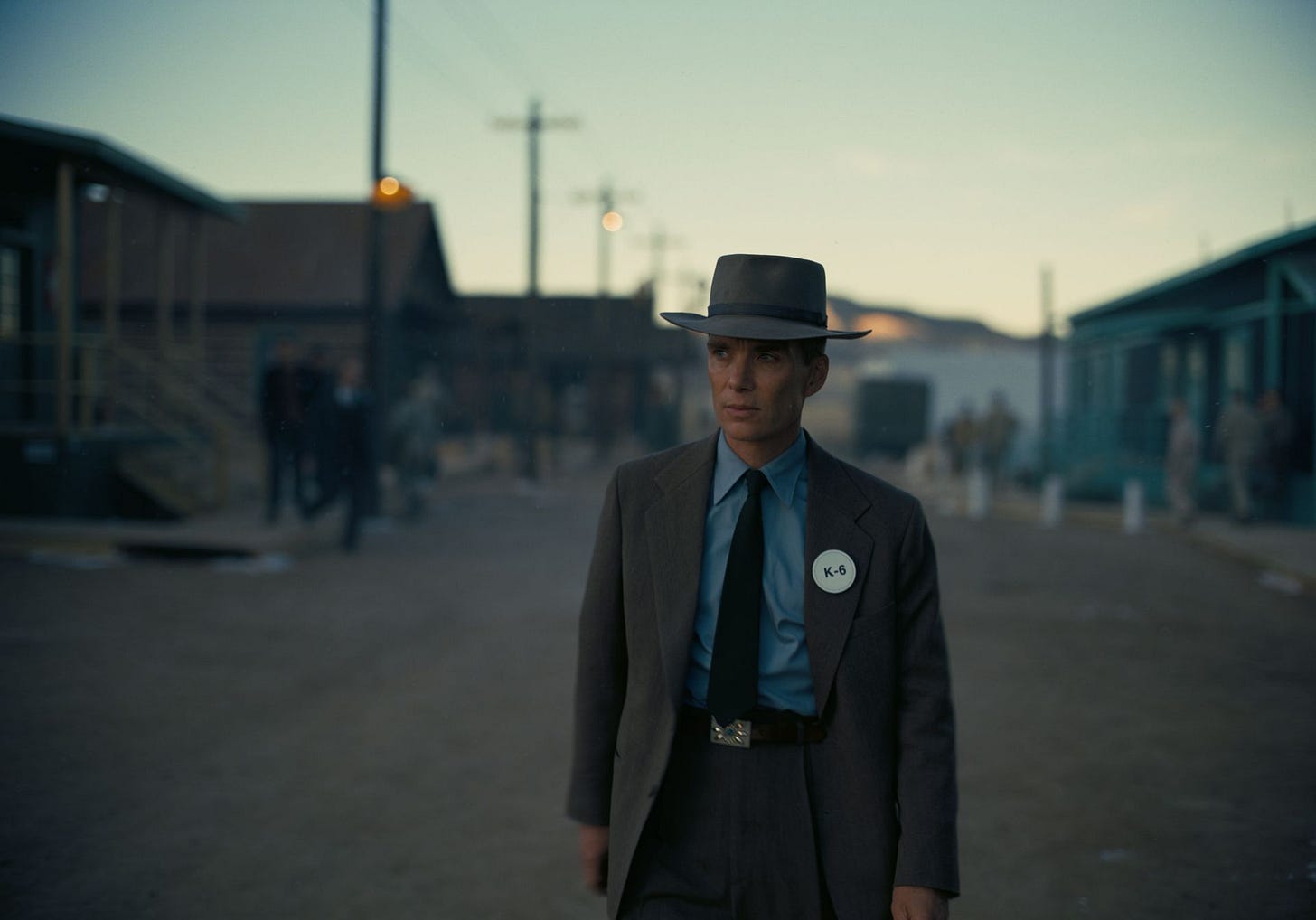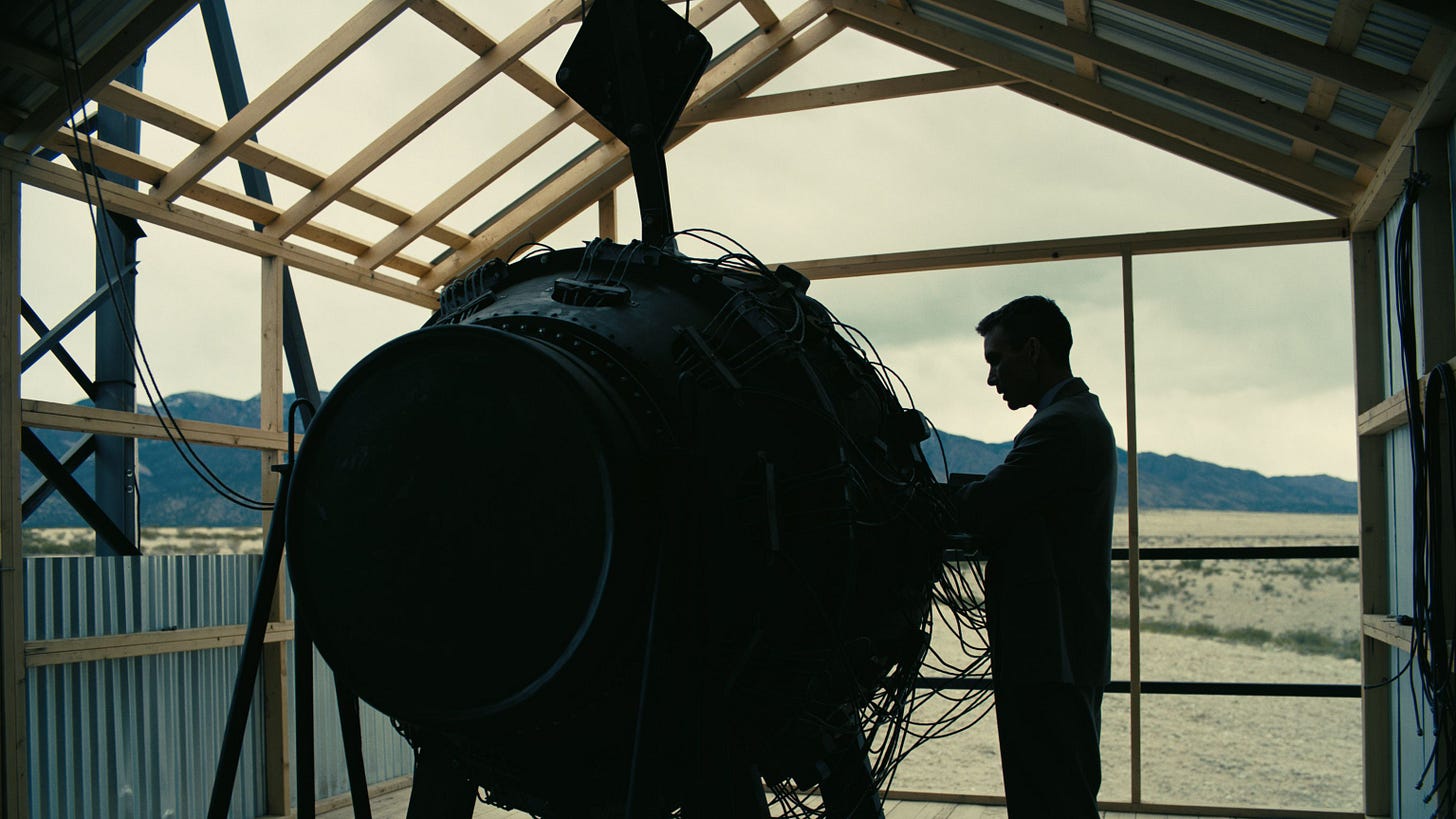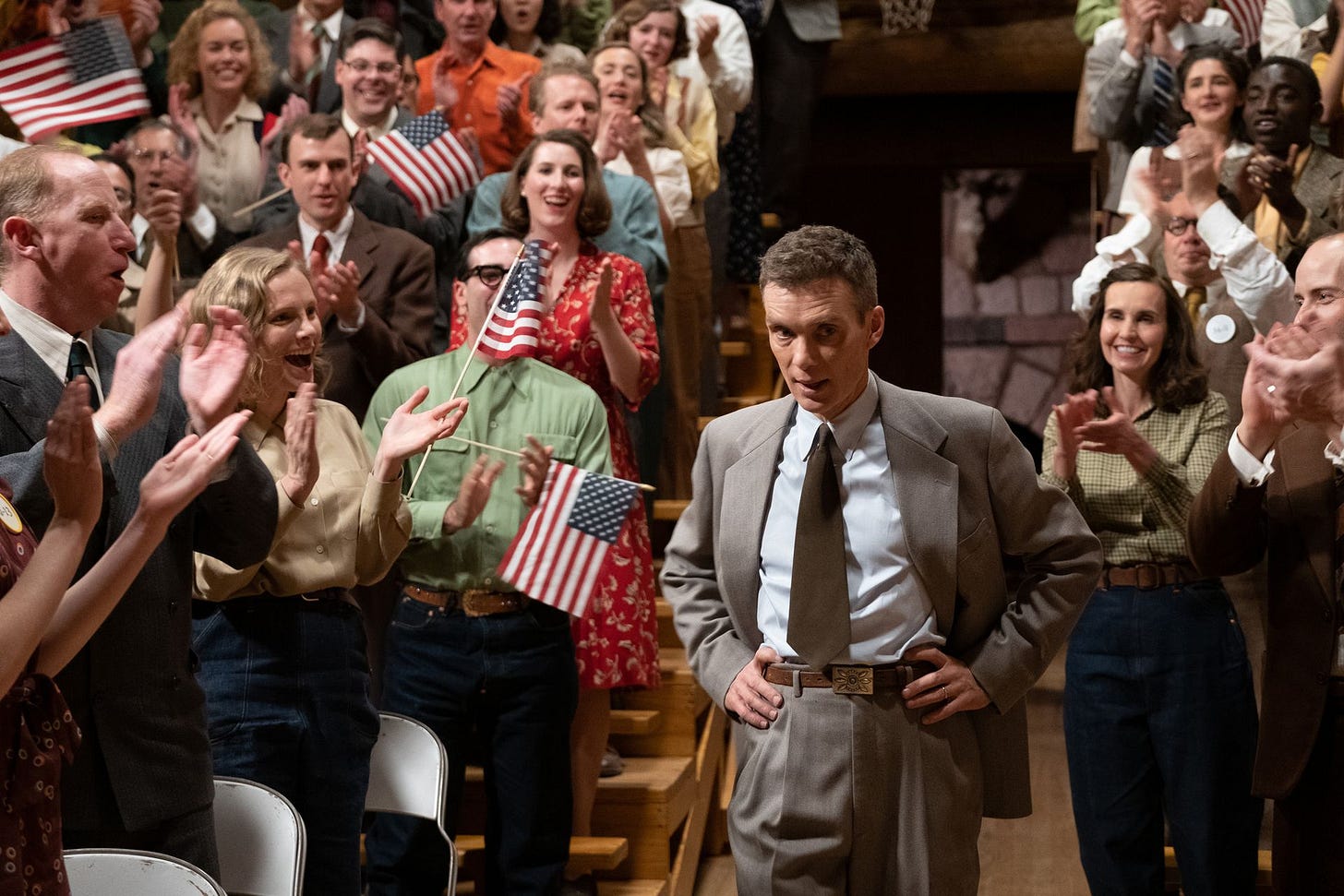Oppenheimer: The Off-Balance Review.
"Now I am become Death, the destroyer of worlds."

We knew the world would not be the same. A few people laughed, a few people cried. Most people were silent. I remembered the line from the Hindu scripture, the Bhagavad Gita. Vishnu is trying to persuade the Prince that he should do his duty and to impress him, takes on his multi-armed form and says, "Now I am become Death, the destroyer of worlds." I suppose we all thought that, one way or another.
J. Robert Oppenheimer, recalling the aftermath of the Trinity Test in 1965.
It is the summer of 1945 and if you venture deep enough into the New Mexico desert, you will find the Los Alamos Laboratory. A planned community, hiding secrets most could never fathom.
Los Alamos: the design and development arm of the Manhattan Project, the top-secret U.S. government initiative that, for the past three years, under the cloud of conflict raging across Europe and the Pacific, has housed a collective of some of the country’s best scientists as they work to build nuclear weapons.
And in the early-morning hours of July 16th, those at Los Alamos are buoyed by an anxious, almost morbid energy.
At approximately 5:30 that morning, they will detonate “Trinity”, the world’s first nuclear weapon, the test, a proving ground for what will shock the world in just a few weeks time. The cumulation of their years-long effort.
But as they count down the minutes and make last-second preparations, one of the program’s scientists, Enrico Fermi (played by Danny Deferrari) can’t help himself: he starts taking bets.
When Trinity detonates, could it set off a chain reaction, “atmospheric ignition”, that will consume the world in nuclear fire and bring untold destruction?
In their drive to supposedly save the world from foreign powers, will these men and women, in their arrogance, bring about its end?
The crux of Oppenheimer, the newest film from writer-director Christopher Nolan, which released to much fanfare last month, is to present a chain reaction all its own. The domino effect of one action, following another, with three storylines being presented simultaneously:
The life of J. Robert Oppenheimer (Cillian Murphy), the brilliant but equally anxious, distant and ego-driven theoretical physicist. From his time in Europe during the 1920s, his complex and later professionally-weaponized personal life, to the period during the Second World War where he was the director of Los Alamos, overseeing the development and later use, of nuclear weapons.
Oppenheimer’s much-publicized 1954 security hearing, where, after spending the post-war years publicly arguing against the use of nuclear weapons and advocating for cooperation with the Soviet Union (at the height of the Cold War, no less) his position and power in government come under intense scrutiny.
And the 1959 Senate confirmation hearing of Lewis Strauss (Robert Downey Jr.) a former associate and later rival of Oppenheimer’s whose political ambitions are not as certain as he wishes them to be.
Admittedly, going in, I was a little skeptical Nolan could successfully present a story with so many threads.
He is a filmmaker known for his love of complicated, interwoven plots which, when successful are the backbone of his best work (Interstellar, Memento, Inception) but can also lapse into the confusing and tedious (Tenet).
But presumably reined in by the real-world story and source material he is working with, the film, an adaption of the Pulitzer-winning biography written by Kai Bird and Martin J. Sherwin, American Prometheus: The Triumph and Tragedy of J. Robert Oppenheimer, doesn’t veer too far off-course.
Nolan builds a narrative that is rich, thematically complex and worthy of the people and the subject matter, still controversial almost 80 years later, it is portraying.
That is not to say it is executed flawlessly.
Even as someone who has done some reading on the period and Oppenheimer previously, it still took me a while to assemble all the moving pieces. In the early-going especially, Nolan jumps between his three storytelling periods with the late-night energy of someone who is trying to cram desperately for a mid-term, overloading the audience with people, scientific principles and things to remember.
As the storylines eventually stabilize, this feeling of whiplash begins to dissipate but never truly goes away. I get the impression that Nolan was given the three hour runtime as a hard cutoff and was going to make sure he maximized absolutely every minute, overall clarity be dammed.
And while the artistic decisions made to differentiate between these periods are inspired - for example, the sequences featuring Downey Jr’s Strauss are presented in black-and-white, giving them the feeling of a claustrophobic courtroom drama, the film doesn’t really hit its stride until an hour or so in.
In 1942, Matt Damon’s Major General Leslie Groves, the director of the Manhattan Project, finds Oppenheimer while he is teaching at Berkeley. He offers him the project of a lifetime.
Groves needs someone to build an atomic bomb before America’s enemies do. He needs Oppenheimer. And he needs him now.

This is where the movie is at its best, Nolan and editor Jennifer Lame, reuniting for the second time following Tenet, slowly but methodically, racket up the tension, building towards the moment that will come to birth the atomic age: the Trinity Test.
And as Groves and Oppenheimer begin to assemble “Project Y”, the Los Alamos team, Oppenheimer himself comes into clearer focus too.
In contrast to many of his past roles, Murphy shrinks inwards, his Oppenheimer, lean and gaunt but possessing an impressive magnetism, yet a man full of angst and contradiction all the same.
His quiet leadership of the men and women at Los Alamos is contrasted with a turbulent personal life that his rivals will come to exploit to their own ends. He is a man scientifically enraptured by the concept of building the bomb but at the same time, grows increasingly concerned with how such devices could be improperly weaponized and is horrified by the key role he will come to play in the bombings of Hiroshima and Nagasaki.
Deftly, Murphy balances all these elements, his Oppenheimer, for all his incomparable brilliance, is still just a man, who fears, worries and loves as deeply as anyone, even as he works to build a weapon of untold power and devastation.
It is career-best work that I suspect he will be rightly recognized for (whenever the time comes).
And his co-stars, although not given nearly as much screen-time to work with, turn in strong performances as well.
Groves is a particular highlight, with Damon at his scene-stealing best as he moves between levity, more quiet honesty and stern, military-jingoism with ease.
Similarly, much can be said for Emily Blunt’s Katherine Oppenheimer, the physicist’s wife. A biologist in her own right, she initially seems sidelined but builds towards an impressive, emotionally-dense portrayal that is one of the movie’s best.
Frankly, it is a nice change of pace for a Nolan-helmed film, who often struggles with the writing of his female characters (although I wonder how much that has to do with the real-world history he is adapting, rather than any legitimate creative growth).
Others, from Downey Jr.’s Strauss, a man possessed by his own sense of importance, Florence Pugh’s Jean Tatlock or Tom Conti’s Albert Einstein, who is an occasional mentor and confidante to Oppenheimer, to the various members of the Manhattan Project at large all do good work that is ultimately limited by the nature of the story being told (Oppenheimer’s).
But unlike say, The Flash, another of this summer’s blockbusters, you never feel like these characters are being purposely shortchanged or narratively stunted.
They simply exist in an orbit that is not their own.

Yet it is within the presentation of it all that the film truly shines.
From the sweeping deserts of New Mexico to the cramped confines of a war room, laboratory or office space, each environment is brought to life in its own unique way.
Cinematographer Hoyte van Hoytema, collaborating with Nolan for the fourth time, brings strong technical skill to every frame, never allowing the natural stagnation that comes with say, watching a bunch of scientists standing around theorizing become visually boring, hard as that is.
The film’s centrepiece though, the Trinity Test, is a marvel of practical filmmaking that Nolan has become known for, a sense of visual spectacle that van Hoytema clearly relishes in bringing to the screen. It is a delicate balancing act between damn good moviemaking and depicting a historical event that had horrific, real-world repercussions that are still debated today.
No, Nolan didn’t actually detonate a bomb, as was speculated in some circles but his absolute commitment to more grounded filmmaking over CGI shines through.
Ultimately, if I had one substantial piece of criticism for Oppenheimer, outside of the ebbs and flows that come with watching a three-hour movie, it is what, unfortunately, is becoming a recurring issue with Nolan’s films - the sound design.
Yes, Ludwig Göransson’s score is terrific, often matching or even exceeding the emotional heft of what is being shown on screen but too often, it becomes overpowering, thundering its way into a scene and completely drowning out the dialogue during key moments of the film.
It is a problem and something you would hope, Nolan, after experiencing similar criticism with Tenet, would look to address.
Instead, it seems he has chosen to double down with the most “It is the way it is supposed to be, dammit!” defense possible.
As someone who is hard of hearing, I’m wary to wade into such debates. If I can’t hear it, I usually suspect it is a “me” problem. But it was a complaint I heard from both those I saw the movie with and others in my theatre. What it comes down too, is that Oppenheimer, too often, seems to be actively hostile to making sure it is understood, which is beyond frustrating (you’re allowed to dub your dialogue in post-production, Nolan. I won’t tell anyone).
Despite this, Oppenheimer, sometimes in defiance, stands tall.
Both a celebration and a warning of the scientific ingenuity, that brought nothing but death and destruction to the people of Japan.
A film, that works to bring humanity to a man some would argue, given his role in the above, doesn’t deserve it.
It may not be Nolan’s best film (I would argue that is still Dunkirk) but it is his most accomplished, a feat of filmmaking matched only by the material it presents.
"Now I am become Death, the destroyer of worlds."





